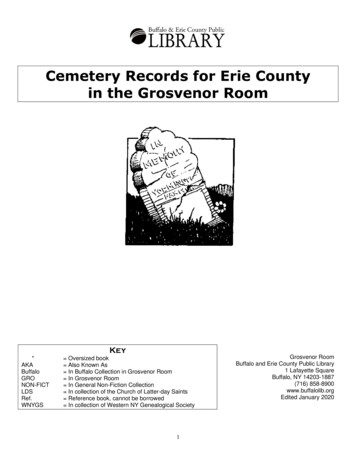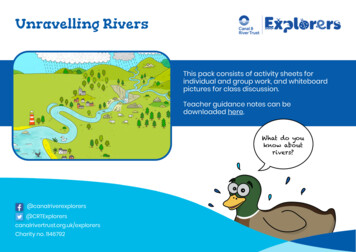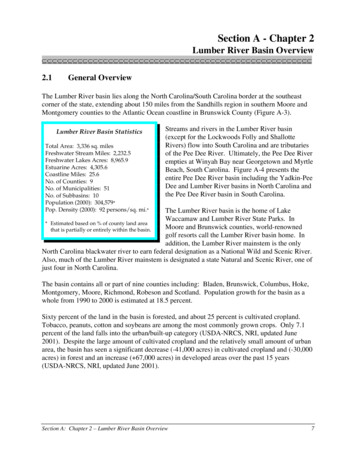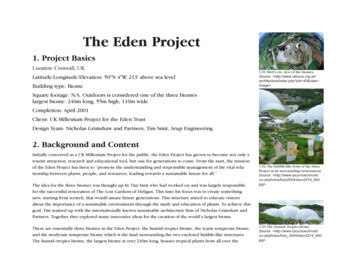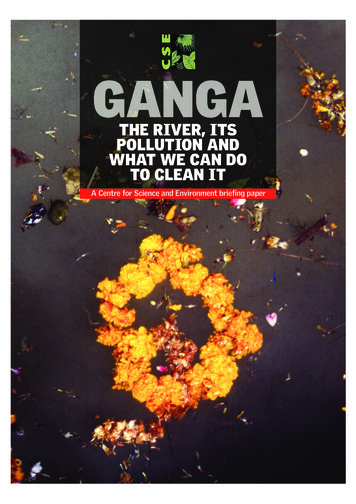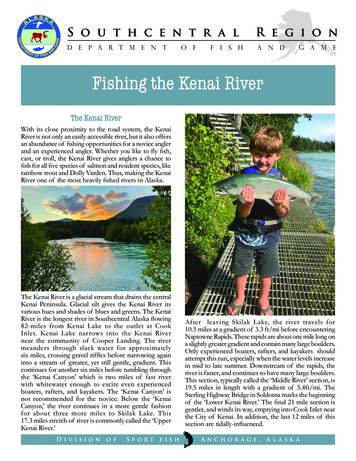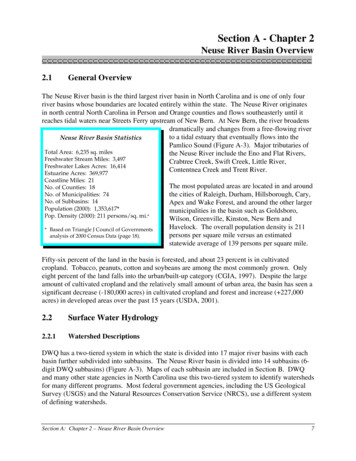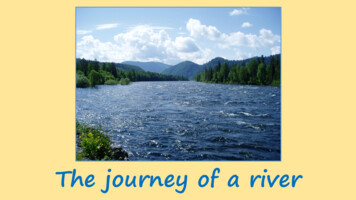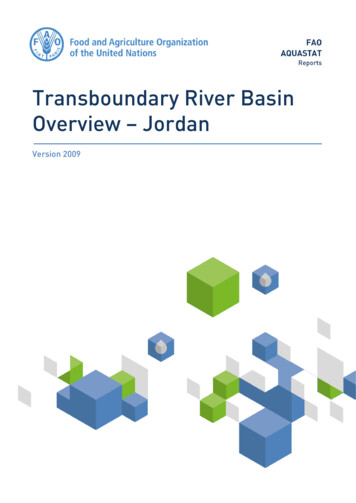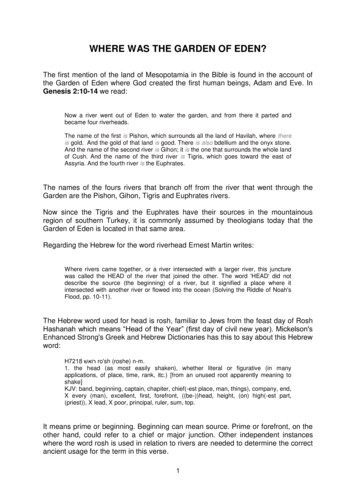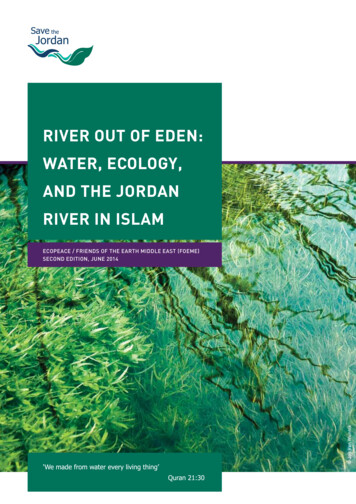
Transcription
RIVER OUT OF EDEN:WATER, ECOLOGY,AND THE JORDANRIVER IN ISLAM Jos Van WunnikECOPEACE / FRIENDS OF THE EARTH MIDDLE EAST (FoEME)second EDITION, June 2014
COVENANT FOR THEJORDAN RIVERWe recognize that the Jordan River Valley isa landscape of outstanding ecological andcultural importance. It connects the ecosystems of Africa and Asia, forms a sanctuaryfor wild plants and animals, and has witnessedsome of the most significant advances inhuman history. The first people ever to leaveAfrica walked through this valley and drankfrom its springs. Farming developed on theseplains, and in Jericho we see the origins ofurban civilization itself. Not least, the river runsthrough the heart of our spiritual traditions:some of the founding stories of Judaism,Christianity, and Islam are set along its banksand the valley contains sites sacred to halfof humanity. By any measure, this landscapemust be counted as part of the heritage ofhumankind.But over the past 50 years, the Lower JordanRiver has been destroyed. 96% of its historicflow has been diverted. What little waterremains is polluted with saline and effluent,including untreated sewage. The valley’swetlands have dried up, its springs are failing,and half its biodiversity has been lost. This isnot just a tragedy for wildlife: families haveseen their fields turn to dust, not from a lack ofwater but from the injustice of its distribution.The demise of the Jordan and the collapse of thevalley’s eco-system represents a failure of ourmost basic responsibility towards the specieswhose habitats have been destroyed and theecological systems that sustain life on earth.It is a neglect that leaves us impoverished,that cripples the growth of an economybased on tourism, and that exacerbates thepolitical conflicts that divide this region. Italso exemplifies a wider failure to serve ascustodians of the planet: if we cannot protect aplace of such exceptional value, what part of theearth will we hand on intact to our children?We have a different vision of this valley: a visionin which a clean, living river flows from the Seaof Galilee to the Dead Sea; in which the valley’splants and animals are afforded the water theyneed to flourish; in which the springs flow asthey have for millennia; and in which the waterextracted for human use is divided equitablybetween the nations that share the valley andthe people who live here.Realizing this vision will not be easy. Butdifficulty cannot be an excuse for inaction. Wetherefore call upon the governments of thecountries that share this watershed to make aserious commitment of resources and politicalcapital to the rehabilitation of the Jordan River.As individuals and organizations, as membersof civil society, and as religious or communityleaders, we also affirm that this is a landscapeof universal ecological, cultural, and spiritualimportance, and commit to work towards thevision expressed in this covenant.
Dear Friends,This is a toolkit of information to help Islamic communities around the world learn about thecontemporary reality the Holy Jordan River and join in efforts to rehabilitate the once mightyJordan.At the beginning of the booklet you will find background information describing the demise of theJordan River, what went wrong and why it matters to our community. The second section includesa compilation of writings about the Jordan River in the Muslim tradition, about the sacrednessof water, and about the connection between spiritual faith and care for the natural world. Threespecially commissioned pieces of writing about the state of the river and about the role of theMuslim community in its rehabilitation are also included. You are welcome to use these works asthe basis for your own presentations or sermons, or to adapt them to suit your audience. You willalso find scriptural texts, prayers, and essays.Section three includes sample lesson plans and questions to assist community educators indesigning programs for a wide range of age groups on this issue. Finally, we’ve prepared somesuggestions for how your community can support regional efforts to rehabilitate the Jordan Riverby taking action to let decision makers know that we care about the revitalization of the Jordan.Additional resources to support awareness campaigns and plan visits to the river are available atwww.SavetheJordan.com.We encourage you to treat this as a working document: to annotate it, to select what is mostilluminating for your own teaching, and to enrich it through your own knowledge and insight.We hope that these materials inspire your congregation or class to join in the campaign to revivethe Jordan River.With gratitude,EcoPeace / Friends of the Earth Middle EastJune 2014
Table Of ContentsCovenant for the Jordan River3I. BACKGROUND11A Man-Made Disaster13A Source of Life14A Blessed Land15An Ecosystem Destroyed16The Destruction of the Jordan Some Facts and Figures17A Failure of Wisdom18A New Vision of the Valley20A Measure of Progress21Justice, Peace, Prosperity22Reviving the Jordan23II. WATER, ECOLOGY, AND THE JORDAN RIVER IN ISLAMProf. Mustafa Abu SwayDr. Husna Ahmed2833Water in the Holy Quran34Care for the Earth in Hadith and Sunna357Reviving the Jordan: A Challenge for Young MuslimsProtecting the Jordan River26Imam Zaid ShakirRIVER OUT OF EDENIslam, Muslims and the Jordan River25
The Jordan Valley in Islamic History36Other Quotes on Water and Creation37Declarations and Essays on Islam and Ecology38The Islamic Declaration on Sustainable Development41Islam and Water Management:Overview and Principles Naser I. Faruqui42III. EDUCATIONAL RESOURCES45Rationalization of Water and Waste46Lessons That Can Help You48IV. IDEAS FOR COMMUNITY ACTION53V. CREDITS57
I. BackgroundThe Jordan River has suffered an ecological collapse. What wentwrong and why it matters to our community.
Francesco ZizzolaA man-made disasterFor thousands of years the Jordan River brought life to one of the culturalheartlands of the Islamic world.It’s not too late. Eco-Peace / Friends of the Earth Middle East (FoEME) asksyou to join us in calling for a return of water to this river, and a return of life tothe Jordan Valley.RIVER OUT OF EDENThis is a man-made disaster – one that shows an utter disregard for the natural world, for our own spiritual tradition, and for our responsibility as custodians of God’s earth.13Today, the river has been all but destroyed. 96% of its flow has been diverted.What little water remains is polluted with saline and untreated sewage. Thevalley’s wetlands have dried up, its springs are failing, and half its biodiversityhas been lost.
“By any measure – ecological,cultural, spiritual - this river must Jonathan Kalan / FoEMEbe counted as part of the heritageof humankind, and as a place ofexceptional importanceto Muslims.”A source of lifeWe know that this river is important in thestories of the Prophets Yusha Ibn Nun (Joshua)and Yahya Ibn Zakariya (John the Baptist) andIsa (Jesus) – peace be upon them all – and thatmany of the closest Companions of the ProphetMohammed (SAAS) are also buried in the valley,to the east of the Jordan.This is a river, then, that flows through the heartof the Islamic world. It is a river of life.Until about 50 years ago, the river looked muchas it did in the time of the Companions of theProphet (SAAS). From its source in the foothillsof Jabal esh-Sheikh the Jordan rushed southAll along the way, the Jordan River broughtlife to the valley. It created wetland habitatsin which wild plants and animals flourished.It greened a corridor through the desert,connecting the eco-systems of Eastern Africaand Western Asia and forming a flyway used bysome 500 million migratory birds each year. Andit allowed the flourishing of human life and theemergence of urban civilization.Some of the first people ever to leave Africawalked across this plain and drank from itssprings. And it was here, too, that the world’sfirst farmers began to plant and harvest grainin the alluvial mud north of the Dead Sea.Agriculture was the breakthrough that allowedvillages to develop into the world’s first realtowns, Jericho among them. Jericho’s wallswere built some 10,000 years ago, and it canclaim to be the oldest continuously inhabitedcity anywhere in the world.A Blessed LandThe Jordan Valley has been central to Muslimhistory and culture since the time of Islam’sexpansion under Caliph Umar.It was here that the Muslim armies, includingmany who had known the Prophet (SAAS),fought one of the decisive battles at Fahl (Pella)in 635 CE. Some of the closest Companions ofthe Prophet (SAAS) are buried on the Jordanianside of the river. They include Zayd ibn AlHarithah, the adopted son of the Prophet(SAAS); Ja‘far ibn Abi Talib, the cousin of theProphet (SAAS); Abu ‘Ubaydah ibn al-Jarrah,one of the first to accept Islam and latersupreme commander of the Arab armies underCaliph Umar; Bilal bin Rabah, who served asmu’azin to the Prophet (SAAS); Dirar bin AlAzwar, an early Companion and renownedwarrior; and Sharhabil Bin Hassneh, amongthe most trusted of the Prophet’s (SAAS)Companions and, according to some, one of thescribes of the Holy Quran.15In the mind’s eye we see a great river – a riverthat brings life to al ard al muqadasa - the HolyLand - described in the Quran as the “land thatWe had blessed for the worlds” (Quran, 21:71).into Lake Tiberius, and then meandered moreslowly along the length of the Jordan Valleyuntil it disappeared into the intensely salinelake of the Dead Sea – the lowest point on thesurface of the earth.RIVER OUT OF EDENImagine the River Jordan.
As the river has dried up, the Jordan Valleyhas suffered an ecological collapse. Half thevalley’s biodiversity has been lost. The Dead Sea,sustained only by inflowing water from the Jordan,is sinking by more than a meter every year.This is not just a tragedy for wildlife. Springsthat irrigated farmland for thousands of yearshave started to falter and fail. Wells used forgenerations have run dry. Refused access tothe river and denied a fair share of the waterpumped from beneath the land, Palestiniancommunities have seen fields turn to dust,“The neglect of this river exacts a heavyprice from the nations that share thevalley, crippling the growth of an economythat could be supported by tourism andexacerbating the political conflicts thatdivide the region.” The Lower Jordan River begins at LakeTiberius and flows south for about 120kmbefore reaching its end at the Dead Sea. The diversion and pollution of thiswater has caused an ecologicalcollapse - more than 50% of the valley’sbiodiversity has been lost. The Lower Jordan Valley is divided betweenJordanians, Israelis, and Palestinians.Palestinians have no access to the Jordanand do not receive water directly from theriver. The dying of the Jordan is also causingthe Dead Sea to disappear – it is nowsinking at the rate of approximately onemeter per year. Until about 1950, some 1.3 billion cubicmeters of water flowed through the valleyevery year. FoEME estimates that Israel diverts abouthalf of the river’s average annual flow,while Syria and Jordan take the rest. 96% of that flow has been diverted. Untreated or poorly treated sewage hasbeen dumped or allowed to leak intothe river for over 50 years from Israeli,Jordanian, and Palestinian communities.17In just over 50 years, the countries that sharethis watershed have dammed and diverted morethan 96% of the river’s historic flow. What littlewater remains is polluted with saline, sewage,and agricultural run-off. In places, the river islittle more than a stagnant canal of effluent.livelihoods lost, and families forced to migrate.The neglect of this river shows a disregard forour own cultural heritage and for our moralresponsibility as custodians of God’s creation.It also exacts a heavy price from the nationsthat share the valley, crippling the growth of aneconomy that could be supported by tourismand exacerbating the political conflicts thatdivide the region. This is an ecological collapsewhose severity and cost – economic, ecological,human – we are only now beginning to count.RIVER OUT OF EDENNeither the natural beauty nor the spiritualsignificance of the Jordan has been enough tosave the river from being degraded. Daniel Adamson / FoEME Jonathan Kalan / FoEMEAn ecosystem destroyedTHE DESTRUCTION OFTHE JORDANSOME FACTS AND FIGURES
“All the natural resources in thisworld are trusts, and it is thereligious duty of Muslims to takecare of these sources and use Jonathan Kalan / FoEMEthem in a sustainable manner.The Jordan River is included.”Prof. Mustafa Abu Sway (Al AqsaMosque & Al Quds University)A failure of wisdomGiven the intensity of political conflict in theregion, this zero-sum struggle for the valley’swater might seem inevitable. But it is, in thelong term, an approach that will underminethe interests of all concerned. This is a singlewatershed: the flow of its streams does notcorrespond to the borders drawn on our maps,and its rain and rivers cannot be sustainablymanaged through a process of competition.The abuse of nature is surely not what wasintended when God appointed man as His ViceRegent (Khalifah) on earth. As Dr. AbdullahOmar Nasseef, Secretary General of the MuslimWorld League, wrote in the Islamic Declarationon Nature in Assisi in 1986 For the Muslim, mankind's role on earth isthat of a Khalifah – Vice-Regent or trustee ofAllah. We are Allah's stewards and agentson Earth. We are not masters of this Earth;it does not belong to us to do what we wish.It belongs to Allah and He has entrusted uswith its safekeeping.This duty to care for the earth that Godentrusted to us was modeled by the Prophet(SAAS), especially in regard to the use of water –Abdullah Ibn ‘Amr reported that ProphetMuhammad (SAAS) “passed by Sa d [Ibn AbiWaqqas] while he was performing ablutionand said to him: Why the excessive use ofwater? [Sa d] asked: Even in ablution thereis excessive use of water? [The Prophet]replied: Yes, even if you were at a flowingriver.” (Narrated by Ibn Majah, Ch.2)The respect for water and for all of nature,shown by the Prophet (SAAS) has been lost,along with our sense of wonder at the creationand of responsibility for the world that Godmade. All of this has contributed to thedestruction of the Jordan River. The revival ofthe Jordan, then, requires not just a shift inpolicy, but a renewed spiritual effort to honorthe creation that God has entrusted to us.19At the root of the problem is conflict. The basinthat drains into the Jordan River is dividedbetween Lebanese, Syrians, Jordanians,Israelis, and Palestinians. Instead of seeing thevalley as a single, trans-boundary watershed,these nations have raced to capture the greatestpossible share of the Jordan’s water. FoEMEestimates that Israel diverts about half of theriver’s average annual flow, while Syria andJordan take about a quarter each. Palestinians,denied access to the river, take almost nothing.The degradation of this valley also reveals aprofound failure of respect for the natural andnon-human world. It exemplifies an attitudein which nature, including its water and all itsforms of life, is seen as nothing more than acollection of resources to be mined for humanuse. This directly contravenes our Muslim duty,clearly expressed in the sunna of the ProphetMohammed (SAAS) to show respect to allliving creatures. As recorded in the hadith, theProphet (SAAS) said “There is reward in [caringfor] every living being” (Sahih Muslim, Ch. 7).RIVER OUT OF EDENWhy has this happened? How have we allowedthis to happen to a place of such exceptionalbeauty and value?
Given the scarcity of water in parts of this regionand the state of relations between the countriesthat share the valley, realizing this vision will notbe easy. But difficulty cannot be an excuse forinaction. To do nothing is to leave a landscapeirreparably damaged by our own neglect.The starting point of any new approach must beto see this river and its tributaries as a single,interconnected ecosystem. If we want theJordan to survive – if we want to use this waterto sustain farms and families and economies –we have no choice but to manage it sustainablythrough cooperation.“If we want the Jordan to survive, we haveno choice but to manage it sustainablythrough cooperation.”In the last three years we have seen the first signsof progress in the struggle to revive the river.Responding to years of advocacy, nationalgovernments and municipalities are nowworking to prevent the dumping or leaking ofuntreated sewage into the river. New treatmentplants are in development in Jordanian, Israeli,and Palestinian communities throughout theJordan Valley. FoEME is confident that half acentury of using the Jordan as a sewage canalcould soon come to an end.2013 also saw the first release of clean waterinto the Jordan River in 49 years. The IsraeliWater Authority has agreed to allocate 30mcm(million cubic meters) of fresh water everyyear from Lake Tiberius to help revive the river.This sets an important precedent for futureallocations, but it falls far short of FoEME’srecommendation that a third of the historic flowbe returned as part of an international effort torehabilitate the Jordan.FoEME is also developing the first cross-bordermaster plan for the management of the JordanRiver Valley – a plan that takes account of thevalley’s fragile ecology as well as recognizingthe legitimate human need to draw on its waterresources.The plan puts scientifically sound andeconomically realistic policy recommendationsbehind our vision for the Jordan. Keyrecommendations include the return of 400600 mcm (million cubic meters) of freshwater to the river; an end to the dumpingof raw or poorly-treated sewage, saline,and other effluents into the stream; and theestablishment of functioning internationalmechanisms for the joint management of thevalley’s water. With the support of nationalgovernments, this master plan can become theblueprint for the revival of the river.21This is a vision that reflects our moral andspiritual obligations as Muslims, that showslove and respect for the creation, and that is inharmony with Islam’s attitude of care towardsGod’s earth.A Measure of ProgressRIVER OUT OF EDENFoEME has a different vision for the JordanValley - a vision in which a clean, living riverruns from Lake Tiberius to the Dead Sea; inwhich the valley’s plants, birds and animalsare afforded the water they need to flourish;in which the springs flow as they have formillennia; and in which water extracted forhuman use is divided equitably between thenations that share this valley and amongst thepeople who live here. Ofer Stein Daniel Adamson / FoEMEA New Vision of the Valley
FoEME believes that a living JordanRiver can bring prosperity as well asecological health to this valley, and thatthe management of the valley’s waterprovides a practical opportunity for regionalcooperation and for the advancement ofjustice and peace. FoEME recommends the release of 400600 million cubic meters (mcm) of freshwater into the river every year. In addition, the Jordan needs to flood atleast once each year in order to keep theriver’s ecosystem healthy (100m3/sec for24 hours). FoEME recommends that Israel release220mcm of water into the river eachyear, Syria 100mcm, and Jordan 90mcm.FoEME also recognizes that Palestine, asa riparian to the river, has a right to a fairshare of the Jordan’s water. FoEME’s analysis has identified over abillion cubic meters of water that couldbe saved by these countries (primarilythrough reduction of leaks, improvementsto irrigation efficiency, water harvestingand grey-water recycling, and demandmanagement) and used to revive the riverand to restore Palestinian water rights. The revival of the river requires thatJordanian, Israeli, and Palestiniandecision-makers implement nationalpolicy strategies to manage their owndemand for water, and to cooperate inthe implementation of a comprehensivetrans-boundary master plan for the river. This master plan should determine levelsof water flow, set water quality standards,identify ways to eliminate pollution,define ecological corridors, supportenvironmental rehabilitation programs,and advance plans for the development ofeco-tourism in the Jordan Valley. Implementation of a master plan requiresthe establishment of a functioning transboundary commission to manage thevalley’s water resources, resolve disputes,and strengthen the mechanisms ofcooperation.23In the past decade FoEME has opened ecoparks – ideal places to stay and learn - onboth sides of the Jordan. We are now workingtowards the creation of a trans-boundaryecological peace park centered on one of theriver’s historic crossing points, on the borderbetween Israel and Jordan. This reserve willwelcome visitors from both sides of the valley,providing a much-needed point of access to ariver which, for much of its length, remains aclosed military zone.Reviving the JordanRIVER OUT OF EDENWe believe the Jordan can be revived withoutweakening the valley’s agricultural economy orcausing a shortage of water for human use. Inthe countries that share the valley, FoEME hasidentified over a billion cubic meters of waterthat could be saved (see the fact box below)and used to restore basic water rights to thePalestinians, to revive the Lower Jordan River,and to save the Dead Sea. Francesco Zizzola Israeli Electric Company ArchivesJustice, peace, prosperity
II. WATER, ECOLOGY, AND THE JORDAN RIVER IN ISLAMRIVER OUT OF EDEN25Prophet Mohammed (PBUH) reminded us, we will be held accountable: ‘Verily,this world is sweet and appealing, and Allah placed you as vicegerents therein; He will see what you will do.
Islam, Muslims andthe Jordan River Imam Zaid ShakirZaid Shakir is a prominent American Muslim writer, thinker, and social activist. He cofounded Zaytuna College in California, where he now teaches Islamic law and history.Although the Jordan River contains no specificimport in the life and career of the ProphetMuhammad, some of his most prominentcompanions are buried in the heart of its valley.We can mention among them Abu 'Ubaydah b.The Jordan also has tremendous symbolicvalue. Formed by the meeting of two of theearth's tectonic plates, the river has long beena meeting place for different societies, culturesand religions. Since the advent of Islam, thelands surrounding the Jordan River have beena space where Jews, Christians and Muslimshave been able to not only peacefully coexist,generally, but to create a vibrant and dynamicshared culture. Sadly, in more recent times, alack of coordination and cooperation betweenthe states which have emerged in the areahas resulted in too much water being divertedor pumped out of the river and far too muchsewage and other pollutants deposited intowhat remains of her dissipating flow.Saving the Jordan River will require the jointeffort of all of the people, states and religiouscommunities surrounding her. If we can allcome together to do just that, perhaps a vibrantriver, full with life and surrounded by the lushvegetation that once filled the adjoining valleycan revive our hearts and alert us to the factthat there are interests that transcend those ofour respective nations.“Perhaps a vibrant river can revive ourhearts and alert us to the fact that thereare interests that transcend those of ourrespective nations”There are human, moral and ecologicalinterests that we can ill afford to marginalizeas we have done for much of the 20th Century.If we can bring those interests to the fore andon their bases begin a meaningful restorationof the Jordan River, perhaps the area will onceagain be a meeting place; one symbolizingour ability to transcend conflict through apurposeful pursuit of the common good.27Hence, when Muslims read of those eventstranspiring in the lives of Abraham, Joshua,Lot, John the Baptist or Jesus in and aroundthe area of the Jordan River, we feel as if we arereading Islamic history and we experience anintimate historical connection to the river andits surrounding lands. That connection is onlystrengthened when we reflect on the fact thatthe Jordan River is part of the blessed precinctssurrounding the “Farthest Mosque” (Qur’an18:1), and its terminal point is the Dead Sea, aplace many Muslim exegetes opine is the areareferred to in the Qur’an (30:3) as Adna al-‘Ard(the lowest land).Jarrah; Mu'adh b. Jabal; Shurahbil b. Hasana;'Amr b. Abi Waqqas; and Darar b. al-Azwar. Thespecifically “Muslim” history connecting thelives of these individuals to the area, along withthe Qur'anic references mentioned earlier, onlydeepen its significance in the hearts of Muslims.RIVER OUT OF EDENOne of the beautiful features of Islam, one notfully appreciated by some of its adherents, isits ready acceptance of all of the Prophets andMessengers of God who preceded Muhammad.Hence, Muslims view Abraham, Moses, David,Jesus and many others as Prophets of Islam. Weread in the Qur’an, “We surely sent revelationunto you, as We sent it onto Noah and theProphets succeeding him. We sent revelationto Abraham, Ishmael, Isaac, Jacob, the Tribes,Jesus, Job, Jonah, Aaron, Solomon, and untoDavid we gave the Psalms (4:163).”
Reviving the Jordan:A Challenge for YoungMuslims Dr. Husna AhmedBismillah al-Rahman al-Raheem, in the nameof Allah the most Gracious the most Merciful,As-Salaamu Alaikum.It is wonderful to be with you today to share somethoughts about our precious planet and what partyou and I can play to affect positive change.You - young Muslims, men and women - are ourfuture. Your intentions, deeds and actions willdetermine your destiny and the destiny of thisprecious planet.On behalf of the present and past generationsI want to apologise to you for leaving you aworld which is in turmoil, and crisis, a worldwhere the generations before you only thoughtof themselves (or thought they were doing youa favour by pursuing reckless industrializationand materialism). Global hunger, populationgrowth, poverty, rising debts, wars andinstability within nations – these are all issueswe have to deal with in the 21st century.The elders in the Muslim community tooka long time to wake up; and many are stillsleeping. I apologise to you for this and for thefact that we are leaving such a huge burdenon your shoulder – the burden of climatechange. Climate change has been identifiedas the greatest challenge of all time as wellas increasingly becoming one of the ‘world’sgreatest injustices.’What I don’t want you to do is think you can turnyour back on any of these issues and that they willbe resolved by someone else. If everyone thoughtlike that it would be disastrous for humanity.‘It is Allah who created the heavens andearth, who has sent down water from thesky and with it brought forth produce tonourish you; He has made ships useful toyou, sailing the sea by His command, andthe rivers too; He has made the sun and themoon useful to you.’Qur’an 14: 32-33Islam teaches us to respect Allah’s creationand maintain the balance He created. Allahcommands ‘Do not cause corruption on theearth’ handing us the obligation to practice‘stewardship’ over nature.decades now, conflict and human arrogancehave been responsible for the demise of theLower Jordan River. Cooperation in search ofpeace and sustainability is the only hope torestore it to health.You have a double responsibility as Muslimyouth, because you need to perform yourIslamic duties and show the world that asMuslims you are making a valuable contributionto our precious planet. You want it to be a morebeautiful, peaceful, and just planet. You need tolet the world see how beautiful our actions asMuslims can be; that we are not all terroristsand radicals, we are ordinary decent citizenswho want to live in peace within our Deen.Always remember that Islam is the religionof peace – let us show the world through ouractions and deeds that peace is what we wantfor all citizens of the world.I will speak first of all about the importance ofwater in Islam and particularly the significanceof the Jordan River; and then focus on theactions that you as young Muslims canundertake in partnership with EcoPeace /Friends of the Earth Middle East (FoEME) topush for the rehabilitation of the Jordan Riverand thereby work towards peace in the region.Let us work with other faith communities tobring about positive change in our society andinternationally. Every one of the world’s greattraditions contains a core moral and ethicalunderpinning that life should be just and fair.Let us pursue justice and fairness, let us pursuepoverty alleviation, let us pursue clean drinkingwater for all - by campaigning together, throughadvocacy, through social media and throughglobal and regional causes!The Jordan RiverToday I want to talk to you about getting involvedin a regional cause which is quite unique - Iwould like to talk about the Jordan River. ForWater and IslamThe word for water, Ma appears more than 60times throughout the Quran, as well as otherwords related to water such as rivers, sea,fountains, springs, rain, hail, clouds and winds.The theme of water in the Quran is exploredboth symbolically and at a practical level.‘In the creation of the heavens and the earth,and the alternation of night and day, andthe ships that run in the sea with that whichbenefits mankind, and the water that Allahsends down from the sky, then gives life withit to the earth after its death and spreads init all (kinds of) animals, and the changing ofthe winds and the clouds made subservientbetween heaven and earth, there are surelysigns for a people who understand.’Quran 21:10729The following is a talk addressed to young people within the Islamic community.You may be one person, you may think you areinsignificant, and you’re probably thinking asa young person, who would even listen to you?But trust me you are the key! You are the futureand the hope for humanity.RIVER OUT OF EDENDr. Husna Ahmad (OBE) has a PhD in environmental law from London Un
RIVER OUT OF EDEN: WATER, ECOLOGY, AND THE JORDAN RIVER IN ISLAM ECOPEACE / FRIENDS OF THE EARTH MIDDLE EAST (FOEME) SECOND EDITION, JuNE 2014. COVENANT FOR THE JORDAN RIVER We recognize that the Jordan River Valley is a landscape of outstanding
